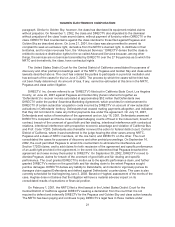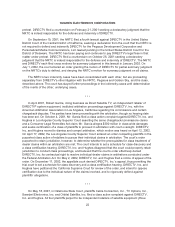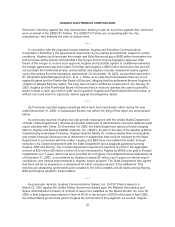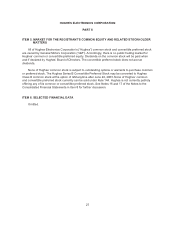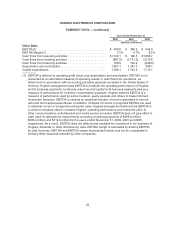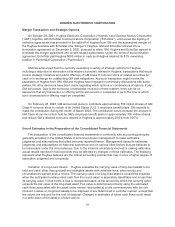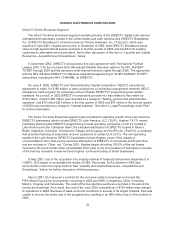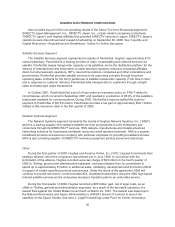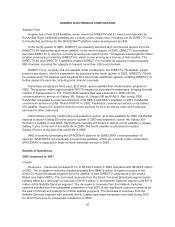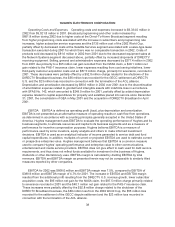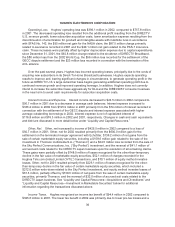DIRECTV 2002 Annual Report Download - page 41
Download and view the complete annual report
Please find page 41 of the 2002 DIRECTV annual report below. You can navigate through the pages in the report by either clicking on the pages listed below, or by using the keyword search tool below to find specific information within the annual report.HUGHES ELECTRONICS CORPORATION
Merger Transaction and Strategic Options
On October 28, 2001, Hughes Electronic Corporation (“Hughes”) and General Motors Corporation
(“GM”), together with EchoStar Communications Corporation (“EchoStar”), announced the signing of
definitive agreements that provided for the split-off of Hughes from GM and the subsequent merger of
the Hughes business with EchoStar (the “Merger”). Hughes, GM and EchoStar entered into a
termination agreement on December 9, 2002, pursuant to which GM, Hughes and EchoStar agreed to
terminate the merger agreement and certain related agreements. Under the terms of the termination
agreement, EchoStar paid Hughes $600 million in cash and Hughes retained its 81% ownership
position in PanAmSat Corporation (“PanAmSat”).
GM has announced that it is currently evaluating a variety of strategic options for Hughes,
including a reduction or elimination of its retained economic interest in Hughes, transactions that would
involve strategic investors and public offerings of GM Class H common stock or related securities for
cash or in exchange for outstanding GM debt obligations. Any such transaction might involve the
separation of Hughes from GM. GM and Hughes have engaged in preliminary discussions with some
parties. No other decisions have been made regarding which options or combinations of options, if any,
GM will pursue. Due to the numerous uncertainties involved in these matters, there can be no
assurance that any transaction or offering will be announced or completed or as to the time at which
such a transaction or offering might be completed.
On February 28, 2003, GM announced plans to contribute approximately 150 million shares of GM
Class H common stock to certain of its United States (“U.S.”) employee benefit plans. GM expects to
make the contribution during the month of March 2003. The contribution would increase the amount of
GM Class H common stock held by GM’s employee benefit plans to approximately 330 million shares
and reduce GM’s retained economic interest in Hughes to approximately 20.0% from 30.7%.
Use of Estimates in the Preparation of the Consolidated Financial Statements
The preparation of the consolidated financial statements in conformity with accounting principles
generally accepted in the United States of America requires management to make estimates,
judgments and assumptions that affect amounts reported therein. Management bases its estimates,
judgments and assumptions on historical experience and on various other factors that are believed to
be reasonable under the circumstances. Due to the inherent uncertainty involved in making estimates,
actual results reported in future periods may be affected by changes in those estimates. The following
represent what Hughes believes are the critical accounting policies that may involve a higher degree of
estimation, judgment and complexity.
Valuation of Long-Lived Assets. Hughes evaluates the carrying value of long-lived assets to be
held and used, other than goodwill and intangible assets with indefinite lives, when events and
circumstances warrant such a review. The carrying value of a long-lived asset is considered impaired
when the anticipated undiscounted cash flow from such asset is separately identifiable and is less than
its carrying value. In that event, a loss is recognized based on the amount by which the carrying value
exceeds the fair value of the long-lived asset. Fair value is determined primarily using the estimated
cash flows associated with the asset under review, discounted at a rate commensurate with the risk
involved. Losses on long-lived assets to be disposed of are determined in a similar manner, except that
fair values are reduced for the cost of disposal. Changes in estimates of future cash flows could result
in a write-down of the asset in a future period.
31


